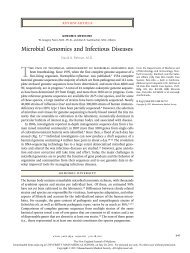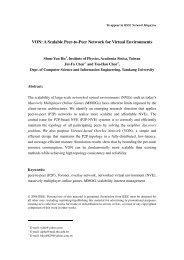3.1 MB - Evernote
3.1 MB - Evernote
3.1 MB - Evernote
You also want an ePaper? Increase the reach of your titles
YUMPU automatically turns print PDFs into web optimized ePapers that Google loves.
79<br />
Validation of the Parallel Simulator<br />
The interesting output for this validation is the output log of the LP. Following this<br />
output log the simulation starts with initialising the GENERATE block (line 4 to 6).<br />
This results in a new Transaction with the ID 1 being chained in for the move time 4.<br />
The model above shows the GENERATE block with an average interarrival time of 3<br />
and a half range of 2. This means that the interarrival times of the generated<br />
Transactions will lie in the open interval (1,5) with possible values of 2, 3 or 4. The<br />
current block of the new Transaction is (1,1) which is the GENERATE block itself as<br />
this Transaction has not been moved yet (in the logging of the parallel simulator a block<br />
reference is shown as a comma separated set of the partition number and the block<br />
number within that partition). The next step of the simulator found in the log is the<br />
updating of the simulation time to the value 4 at line 7 because the first movable<br />
Transaction (the one just generated) has a move time of 4. The lines 8 to 16 show how<br />
this Transaction is moved through the model until it reaches the ADVANCED block<br />
where it is delayed. The first block to be executed by the Transaction is the GENERATE<br />
block which results in a second Transaction being created when the first one is leaving<br />
this block as shown in line 10 and 11. The lines 12 and 13 show the first Transaction<br />
executing the QUEUE and ENTER block until it reaches the ADVANCE block at line<br />
14. The ADVANE block changes the move time of the Transaction from 4 to 9 (delay by<br />
a value of 5), which means that, this Transaction is no longer movable at the simulation<br />
time of 4. At line 16 the Transaction is therefore chain back into the Transaction chain<br />
and because there is no other movable Transaction for the time of 4 the current<br />
simulation time is updated to the move time of the next movable Transaction, which is<br />
the one with an ID of 2 and a move time of 7. In the lines 18 to 26 the second<br />
Transaction is going through the same move process like the first Transaction before<br />
and when it is leaving the GENERATE block this results in a third Transaction with a<br />
move time of 10 being created and chained in. When the ADVANCE block changes the<br />
move time of the second Transaction from 7 to 13 as shown in line 24 the current<br />
simulation time is updated to the value of 9 and the first Transaction starts moving again<br />
(see line 27 to 35). It will execute the LEAVE and DEPART block before reaching the<br />
TRANSFER block at line 34. Here it is transferred directly to the TERMINATE block<br />
which can be seen from the next block property of the Transaction jumping from the<br />
block (1,7) to block (1,10). After executing the TERMINATE block the Transaction<br />
stops moving but is not chained back into the Transaction chain as it has been
















